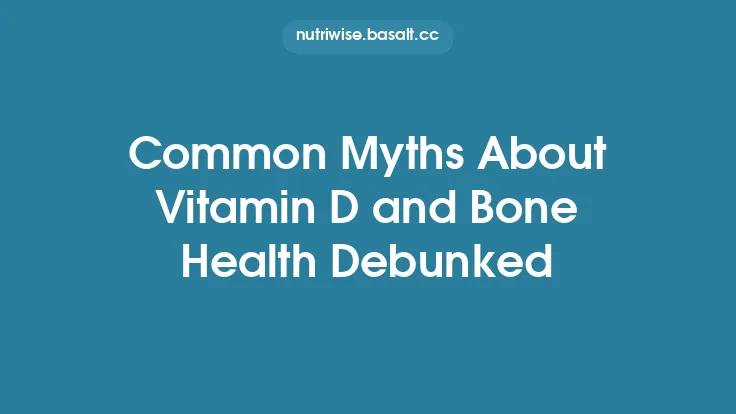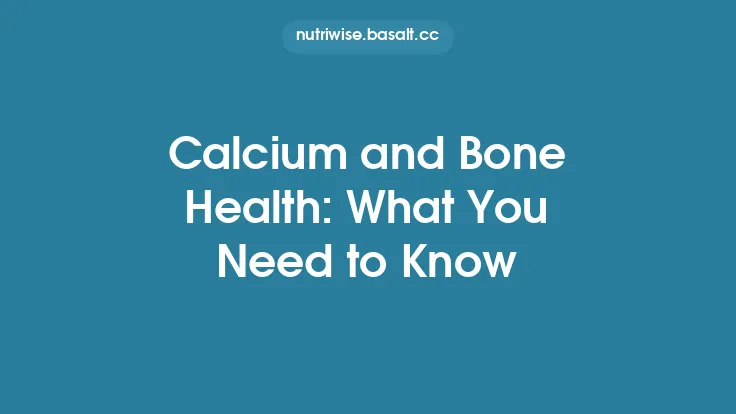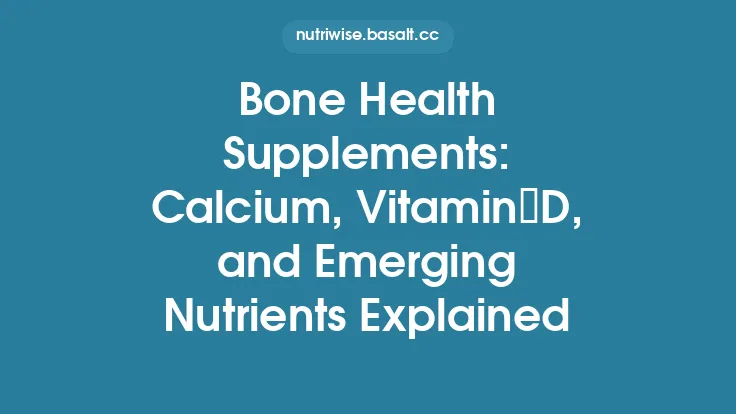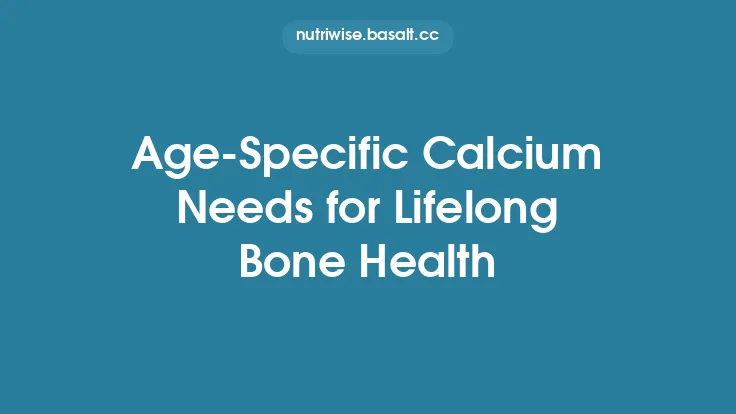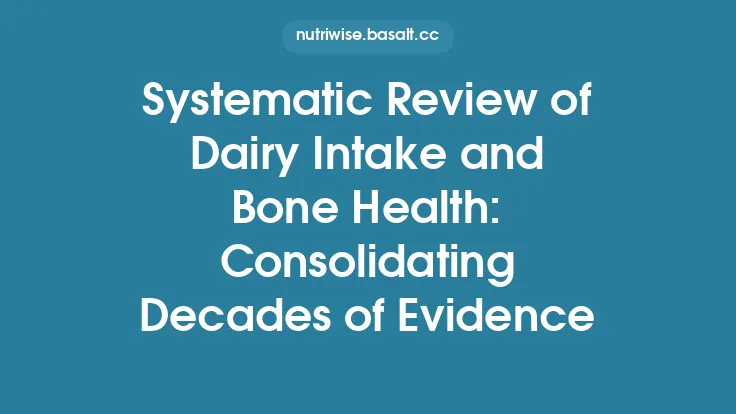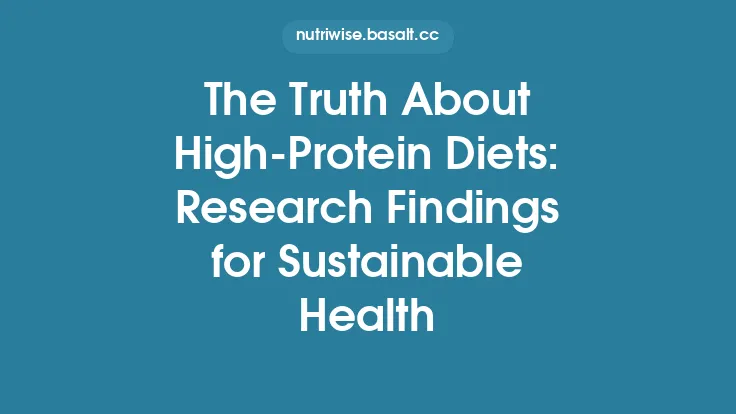Calcium is one of the most talked‑about nutrients when it comes to keeping our skeleton strong, yet the conversation is often clouded by misconceptions that can lead to unnecessary worry or, conversely, a false sense of security. In this article we separate the most persistent myths from the evidence‑based facts, giving you a clear, evergreen perspective on how calcium truly interacts with bone health. By understanding where the hype ends and the science begins, you can make more informed decisions without getting lost in the noise of diet trends, supplement hype, or sensational headlines.
Common Myths About Calcium and Bone Health
| Myth | Why It Persists |
|---|---|
| 1. “More calcium is always better.” | Advertising for dairy products and supplements often touts high‑dose formulas, creating the impression that exceeding the recommended intake will further protect bones. |
| 2. “Milk is the only reliable source of calcium.” | Cultural habits and school nutrition programs have long emphasized milk, leading many to overlook other dietary contributors. |
| 3. “Calcium alone can prevent fractures.” | Headlines that celebrate calcium’s role in bone density sometimes ignore the multifactorial nature of fracture risk. |
| 4. “Calcium causes kidney stones in everyone who takes it.” | Anecdotal reports of stone formation after calcium supplementation have been amplified, despite mixed research findings. |
| 5. “After age 30 you don’t need calcium anymore.” | Misinterpretations of bone remodeling data suggest that calcium intake can be tapered once peak bone mass is reached. |
| 6. “Calcium builds bone like a bank—extra calcium is stored for later.” | The metaphor of a “calcium bank” is appealing, but it oversimplifies the dynamic equilibrium of bone turnover. |
| 7. “High calcium intake leads to heart disease.” | A few high‑profile studies linking calcium supplements to cardiovascular events have generated widespread alarm. |
| 8. “If you’re healthy, you don’t need to worry about calcium at all.” | The belief that a “healthy” lifestyle automatically guarantees adequate calcium can lead to complacency. |
Scientific Facts That Counter These Myths
1. There is an optimal intake range, not an “as‑much‑as‑possible” approach.
The body regulates calcium balance tightly through intestinal absorption, renal excretion, and skeletal remodeling. Consistently exceeding the upper intake level (UL) does not translate into additional bone mineral accrual; instead, excess calcium is excreted or may contribute to soft‑tissue calcification. The recommended dietary allowance (RDA) for most adults (1,000–1,200 mg/day) reflects the amount needed to maintain calcium balance in the context of typical diets.
2. Calcium is abundant in a variety of foods beyond milk.
While dairy is a convenient source, calcium is also present in fortified plant milks, certain fish (e.g., sardines with bones), legumes, nuts, and even some grains. The key point is that a balanced diet can meet the RDA without relying exclusively on one food group.
3. Bone strength depends on more than calcium density.
Bone quality is determined by mineral content, collagen matrix integrity, microarchitecture, and turnover rate. Adequate calcium is necessary, but without sufficient protein, physical loading (weight‑bearing activity), and other micronutrients (e.g., magnesium, vitamin K), the risk of fracture remains. Clinical trials that supplement calcium alone often show modest improvements in bone mineral density (BMD) but limited impact on fracture incidence.
4. Kidney stone risk is nuanced and not universal.
Calcium oxalate stones form when urinary calcium and oxalate concentrations exceed solubility thresholds. In individuals prone to hyperoxaluria, high calcium intake from food can actually reduce stone risk by binding oxalate in the gut and limiting its absorption. Conversely, indiscriminate high‑dose calcium supplements taken without meals may increase urinary calcium and, in susceptible individuals, raise stone risk. Personalized assessment is essential.
5. Calcium needs persist throughout adulthood.
Bone remodeling continues lifelong. While peak bone mass is typically achieved by the third decade, bone resorption gradually outpaces formation with age, especially in post‑menopausal women. Maintaining adequate calcium intake helps mitigate this net loss, supporting structural integrity into later years.
6. The “calcium bank” analogy oversimplifies bone dynamics.
Bone acts as a dynamic reservoir, constantly exchanging calcium with the bloodstream. When dietary calcium is insufficient, the skeleton releases calcium to preserve serum levels, a process that can weaken bone over time. Conversely, excess calcium does not “bank” extra mineral; it is excreted or stored in soft tissues if homeostatic mechanisms are overwhelmed.
7. Cardiovascular concerns are linked primarily to high‑dose supplements, not dietary calcium.**
Meta‑analyses of randomized controlled trials have found no consistent association between calcium from food sources and cardiovascular events. The signal for increased risk appears limited to certain supplement regimens, particularly when calcium is taken in large single doses without concurrent food. This underscores the importance of context—dietary calcium remains safe for heart health.
8. Even “healthy” individuals benefit from mindful calcium intake.
A “healthy” lifestyle often includes regular physical activity and a varied diet, but it does not guarantee that calcium intake meets the RDA. Subclinical deficiencies can exist, especially in populations with limited dairy consumption, high phytate intake, or gastrointestinal conditions that affect absorption. Regular dietary assessment helps ensure adequacy.
How to Evaluate Calcium‑Related Claims
- Check the source of the evidence. Peer‑reviewed studies, systematic reviews, and guidelines from reputable health organizations (e.g., WHO, National Institutes of Health) carry more weight than anecdotal reports or marketing materials.
- Look for context. Claims that “calcium reduces fracture risk by 50%” may be based on studies that combined calcium with vitamin D, used specific populations, or employed high‑dose supplementation. Isolating calcium’s effect requires careful interpretation.
- Consider the dosage and delivery method. Benefits and risks differ between food‑based calcium and high‑dose tablets. The timing of intake (with meals vs. on an empty stomach) also influences outcomes.
- Assess the population relevance. Results from studies on post‑menopausal women may not apply to young men, and vice versa. Age, sex, hormonal status, and baseline dietary patterns all modulate calcium’s impact.
- Beware of “one‑size‑fits‑all” statements. Bone health is multifactorial; any claim that calcium alone can solve a complex problem is likely oversimplified.
Practical Takeaways for Maintaining Bone Health
- Aim for the RDA, not the UL. For most adults, 1,000–1,200 mg of calcium per day is sufficient; exceeding 2,500 mg (the typical UL) offers no added bone benefit and may increase adverse effects.
- Prioritize calcium‑rich foods within a balanced diet. Incorporate a variety of sources—dairy, fortified alternatives, fish with edible bones, legumes, and nuts—to meet needs without overreliance on any single food.
- Combine calcium with other bone‑supporting factors. Adequate protein intake, regular weight‑bearing exercise, and sufficient intake of complementary micronutrients (magnesium, vitamin K) synergize with calcium to enhance bone quality.
- Use supplements judiciously. If dietary intake falls short, a modest supplement (e.g., 500 mg) taken with a meal can help bridge the gap. Avoid mega‑doses unless specifically prescribed by a healthcare professional.
- Monitor personal risk factors. Individuals with a history of kidney stones, hypercalcemia, or certain gastrointestinal disorders should discuss calcium strategies with a clinician to tailor recommendations.
- Stay informed about evolving research. The field of bone metabolism is active; new insights into calcium signaling, genetic influences, and novel therapeutic agents continue to emerge.
Key Resources and Ongoing Research
- National Institutes of Health Office of Dietary Supplements (ODS) – Provides up‑to‑date fact sheets on calcium intake, safety, and research gaps.
- International Osteoporosis Foundation (IOF) – Offers evidence‑based guidelines on nutrition and bone health, emphasizing a holistic approach.
- Recent systematic reviews (2022‑2024) – Summarize the relationship between calcium supplementation, fracture outcomes, and cardiovascular safety, highlighting the importance of dose and context.
- Emerging studies on calcium signaling pathways – Investigate how intracellular calcium flux influences osteoblast and osteoclast activity, potentially opening avenues for targeted therapies beyond simple nutrient replacement.
By dissecting the myths that surround calcium and grounding the discussion in robust scientific evidence, you can navigate the often‑confusing landscape of bone health information with confidence. Remember: calcium is a vital piece of the puzzle, but it works best when integrated into a comprehensive lifestyle that includes balanced nutrition, regular physical activity, and individualized medical guidance.
